�
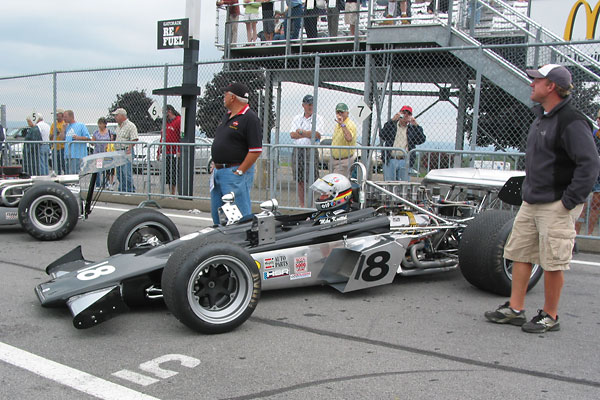
�
Mike Knittel's Chinook Mk12 Formula 5000 Racecar
� � Owner: Mike Knittel� City: Chittenango, New York
� Model: Chinook Mk12 (circa 1970)
� Engine: 1969 Ford Boss 302 V8
� Originally built by: Fejer Brothers, Toronto Ontario
� Restored and race-prepped by: Mike Knittel of Chittenango Auto Repair�
�
Mike Knittel's Chinook Mk12
��
Mike Knittel is a professional mechanic who operates a shop called Chittenango Auto �
Repair about thirteen miles east of Syracuse, New York. Mike has always been �
interested in auto racing and has a particular affinity for Ford engines. However, �
his first racing experience was as a mechanic with a team that campaigned Chevrolet �
Corvettes for four seasons in SCCA's Trans-Am series, back in the seventies. �
�
In 1984, Mike and his wife took a vacation in the Bahamas. They scheduled their �
ten day vacation to span over a five day vintage car race "weekend". Mike explains �
that he thought he would be a spectator, but since he was willing to turn wrenches �
people put him to work. It was a great vacation and it got him hooked on amateur �
vintage racing. He returned home and went back to his regular job, but he was on �
the lookout for a car of his own.�
�
In November 1986, a friend mentioned he'd heard rumors of a formula car with a Ford �
V8 engine for sale up in Buffalo. Not much of a description to go on! Mike got an �
address and went up to have a look. The seller didn't seem to know what he had. �
Mike didn't recognize the car, but the engine was certainly a Ford Boss 302 V8. �
The price was low. Mike bought his Chinook Mk.12 the weekend before Thanksgiving 1986. �
�
�
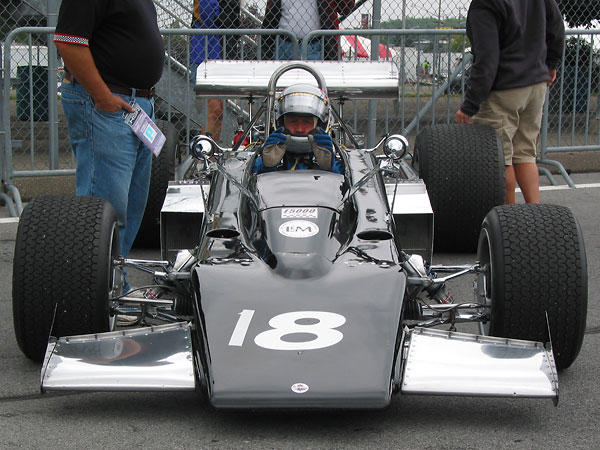
�
A Canadian built race car, but with very strong similarities to a Lotus 70.
�
�
Nearly anyone could be excused for not recognizing the car as a "Chinook Mk.12".�
Frankly, it looks like a Lotus product. In its current, spectacular black paint it �
bears some superficial resemblance to the famous John Player Special Lotus 72 Formula One �
car of 1972. In more specific details, the Chinook resembles one of that car's �
predecessors, the Lotus 70 Formula 5000 model. Lotus only built about nine 70's, �
and the whereabouts of six of them can be found with a quick internet search. �
The Chinook may, possibly, have been built from the remains of a destroyed Lotus 70. �
�
Certainly, actual Lotus suspension components were used in the Chinook Mk.12's �
construction, although exactly how they came to be used isn't public knowledge. The �
Chinook's pivoting cast aluminum upper front shock absorber mount is very distinctly �
a Lotus design feature. The Chinook's suspension uprights have Lotus part numbers cast �
into them. The basic wedge-shaped profile of the body is quite similar too, although �
the panels are different. The Lotus 70 carried a single nosepod-mounted radiator, �
whereas the Chinook has dual sidepod-mounted radiators. The current sidepods are�
newly fabricated, but we haven't found evidence that the Chinook ever carried a nosepod �
mounted radiator. The Chinook's monocoque tub differs from a Lotus in construction �
details too. Incidentally, the quality of Chinook fabrication appears excellent.�
�
�
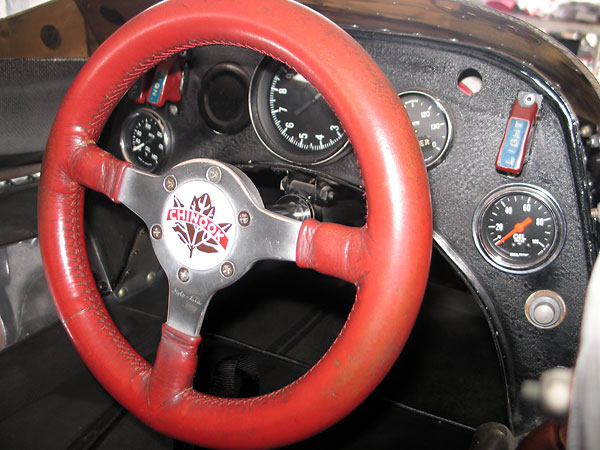
�
The name "Chinook" and the maple leaf trademark belonged to the Fejer Brothers of Toronto, Ontario.
�
George & Rudy Fejer built about 100 race cars of various designs, from Formula Ford through Indy cars.
�
�
Only one Chinook Mk.12 is believed to have been built, and its racing career �
was apparently very short.¹ �
�
The car sat in a barn and collected dust for many years. When Mike found it, the �
engine didn't run and the aluminum monocoque tub was badly oxidized. It seemed to �
have two layers of paint: a turquoise and black paint scheme had been applied over �
an earlier orange paint scheme. �
�
�
Enjoying this article? www.BritishRaceCar.com is partially funded through generous support from readers like you!
�
To contribute to our operating budget, please click here and follow the instructions.
�
(Suggested contribution is twenty bucks per year. Feel free to give more!)�
�
What to do with the car? Mike had the car torn down to a bare chassis by black Friday.�
Putting a car back together is always a bit slower and more difficult, but the �
good news is that almost every original part (excepting rubber hoses and seals) was �
found to be in good condition and could be re-used.�
�
�
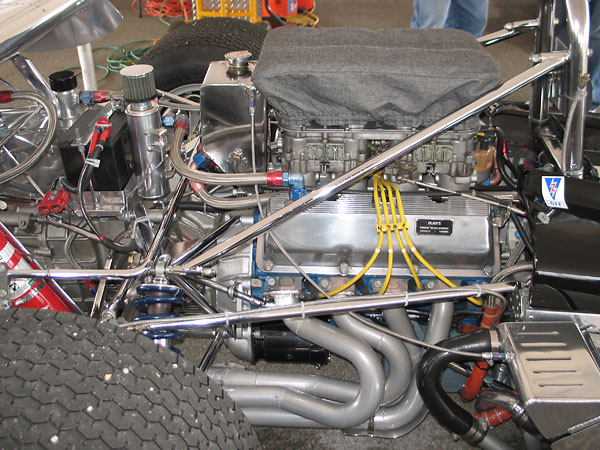
�
1969 Ford Boss 302 V8, bored 0.020" over (4992cc).
�
�
Mike is still racing the original Ford Boss 302 that came in the car. Obviously �
he's rebuilt it, but the only really significant change is in camshaft specs. �
Ford's "canted valve" iron cylinder heads, which characteristically have their �
intake and exhaust valvestems on separate planes, aren't the lightest or the �
best flowing by modern standards, but they're authentic. �
�
The dual Autolite inline four-barrel carburetors are another interesting and �
unusual feature. Ford originally developed their inline four-barrel carbs �
specifically for the Trans-Am race series, but SCCA wouldn't approve their use. �
They're pretty rare, but sometimes they're used by dragracers. In setting them �
up, Mike that found much of Ford's published instructions for tuning them�
is "upside down". He's got them working nicely now, but he wonders how many �
racers gave up in frustration, back in the day. �
�
Mike had his Chinook all back together by September 1998, and he's been entering �
it in occasional races ever since. The car was never really "developed" in its �
original racing career, so Mike has made gradual refinements that are generally �
consistent with the car's original character. Nonetheless, they're noticeable �
improvements. The front wings (shown below, featuring rake adjustment, side plates, �
and Gurney lips) are a good example - they would be revolutionary by 1970 standards. �
Mike's Chinook Mk.12 is a living, breathing race car, not a museum piece! It �
provides him a basis for his own creative expression, while being a car he can �
really enjoy racing. �
�
 �
�
�
�
Features and Specifications
�| Engine: | �1969 Ford Boss 302 V8, bored 0.020" over (4992cc). �
Static compression ratio is 12.5:1.�
JE Pistons forged aluminum pistons, used with Ford "Trans-Am" forged steel rods.�
Ford steel crankshaft. Isky flat tappet camshaft.�
Ford canted-valve iron cylinder heads, fitted with titanium valves.�
Crane needle-bearing fulcrum, roller-tip aluminum rockers (1.73:1). �
Doug Nash intake manifold with two Autolite four barrel carburetors.�
Accel dual point distributor.�
Mallory Voltmaster Mark II coil.�
Dry sump oil system, featuring Weaver Brothers pump. | �
| Cooling: | �dual side-mounted C&R aluminum radiators, plumbed in series. | �
| Exhaust: | �custom four-into-one equal length headers. | �
| Transaxle: | �Hewland LG500 4 speed with Tilton 3-plate 7.25" clutch. Cam and pawl locker. �
3.57:1 final drive. Girling clutch master and slave cylinders. | �
| Front Susp.: | �Lotus uprights.�
KONI 8212 series double adjustable coilover shock absorbers. | �
| Rear Susp.: | �Lotus uprights.�
KONI 8212 series double adjustable coilover shock absorbers.�
(Note: the rear shocks are longer than the fronts, but otherwise they're similar.) | �
| Brakes: | �(master) dual Girling master cylindes with bias bar. � (front) Lockheed (AP) CP2271 four-piston calipers and vented rotors. � (rear) outboard mounted, with Girling calipers and vented rotors. | �
| Wheels/Tires: | �Cooper wheels with Avon tires (24x10.5x15 front and 27x15x15 rear). | �
| Electrical: | �switches (left to right) fuel pump, ignition, lights, starter. �
No charging system. Stock Ford starter motor. | �
| Instruments: | �(left to right)�
Smith's oil temperature gauge (40-140C),�
Stewart Warner tachometer (0-9000rpm),�
Smith's coolant temperature gauge (40-140C),�
AutoMeter oil pressure gauge (0-100psi).�
(A VDO 0-15psi fuel pressure gauge is mounted in the engine area.) | �
| Fuel System: | �original Firestone fuel cells.�
Total capacity is 30 gallons. �
Holley electric fuel pump, rated 110 gallons/hour at up to 15psi. �
Holley adjustable fuel pressure regulator, currently set at 3.5psi. | �
| Safety Eqpmt: | �Crow Enterprises six-point cam-lock safety harness. �
Amerex Halotron I fire extinguisher. | �
| Weight: | �1425 pounds, without driver. | �
| Completion: | �restoration completed September 1988. | �
| Racing Class: | �Formula 5000. | �
Engine Installation
��
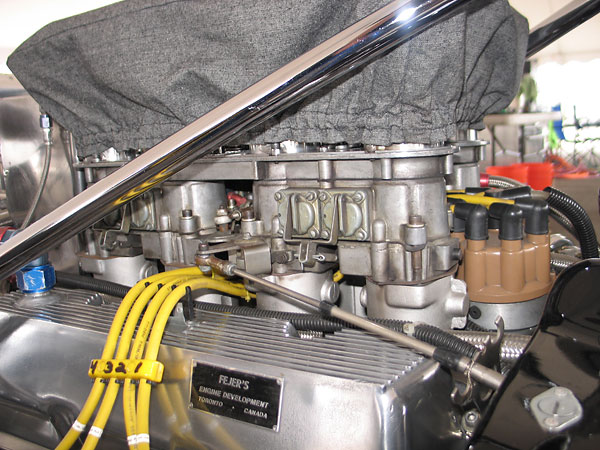
�
Doug Nash intake manifold with dual Autolite inline four-barrel carburetors.
�
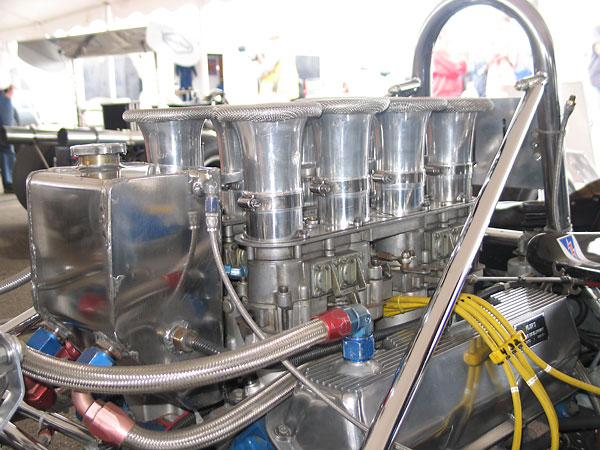
�
Custom fabricated coolant header tank.
�
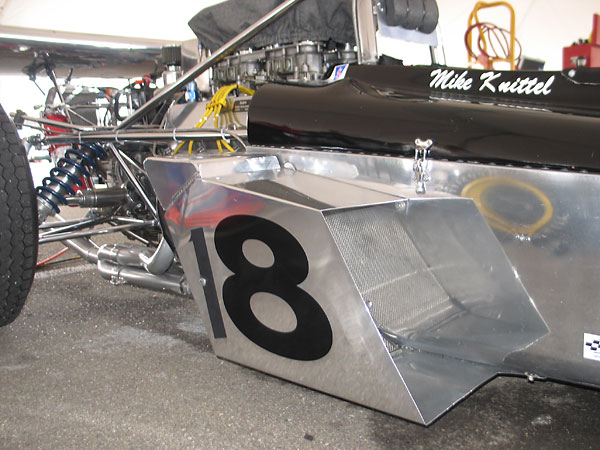
�
The aluminum sidepods are newly fabricated replacements.
�
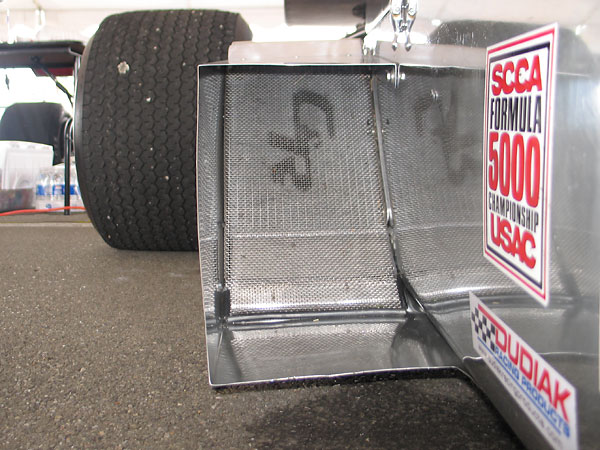
�
Dual sidepod mounted C&R aluminum radiators, plumbed in series.
�
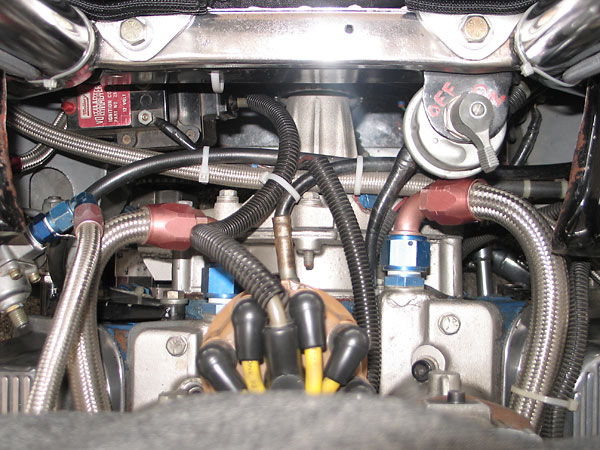
�
Accel dual point distributor. Mallory Voltmaster Mark II coil.
�
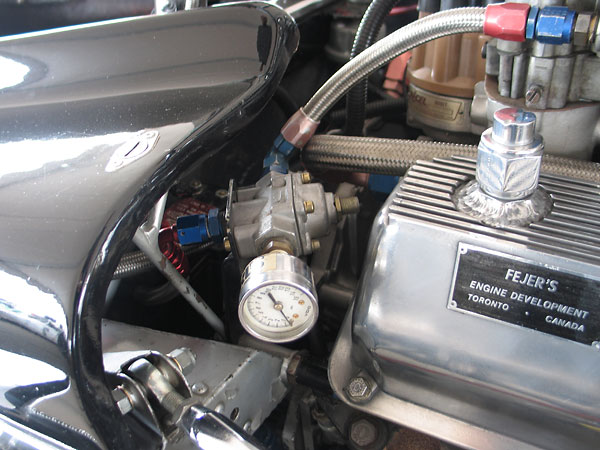
�
Holley fuel pressure regulator, with VDO 0-15psi fuel pressure gauge.
�
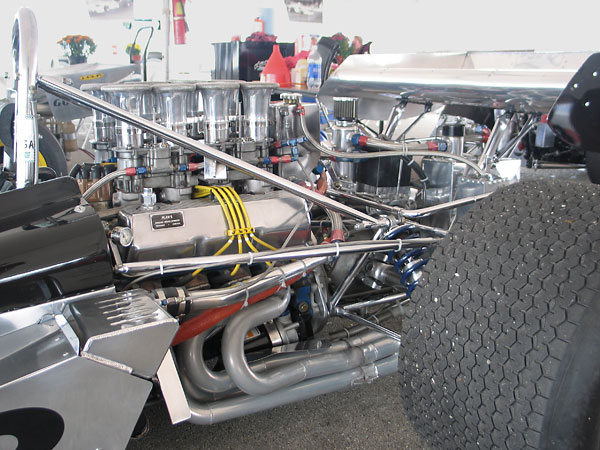
�
Custom four-into-one equal length headers.
�
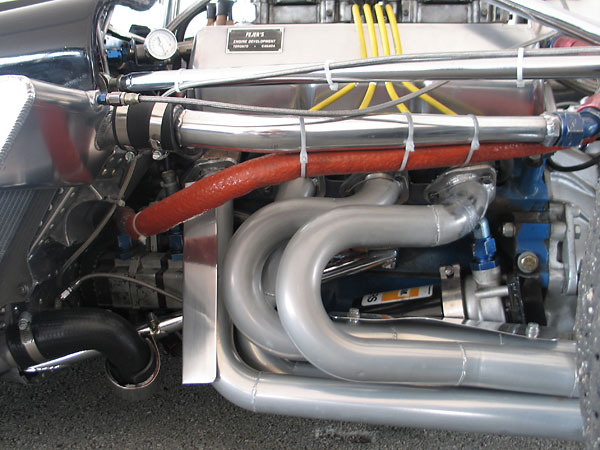
�
Dry sump oil system, featuring Weaver Brothers pump. Remote mounted Wix oil filter.
�
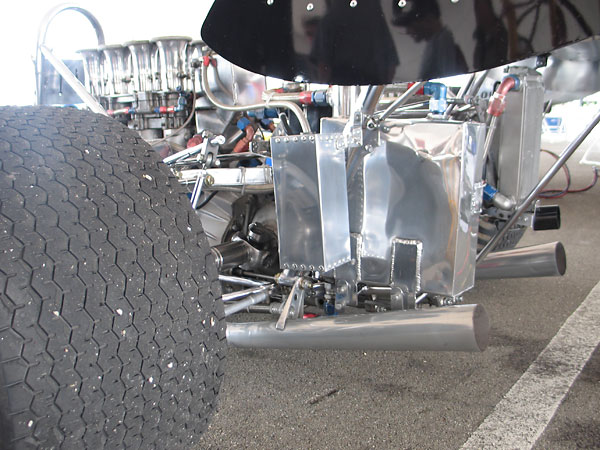
�
Dry sump oil reservoir.
�
�
Front Suspension
��
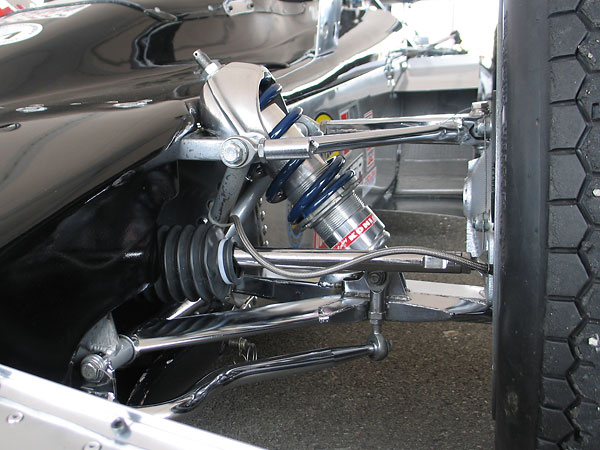
�
The pivoting cast-aluminum shock absorber mounting was clearly derived from a Lotus 70.
�
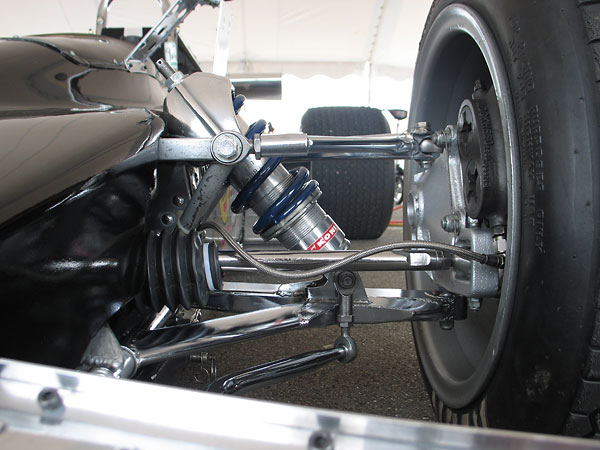
�
Both front and rear uprights are Lotus parts too.
�
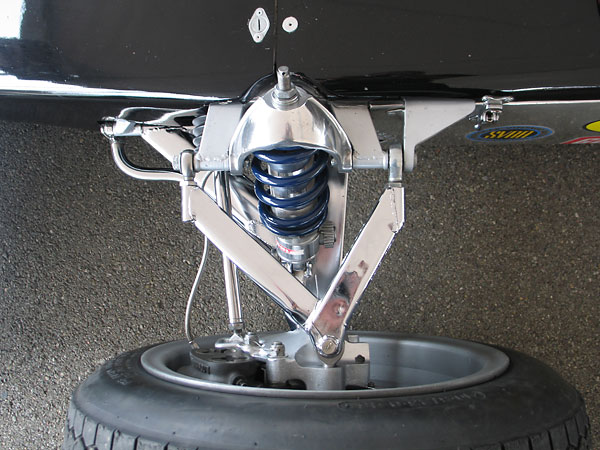
�
KONI 8212 series double adjustable coilover shock absorbers.
�
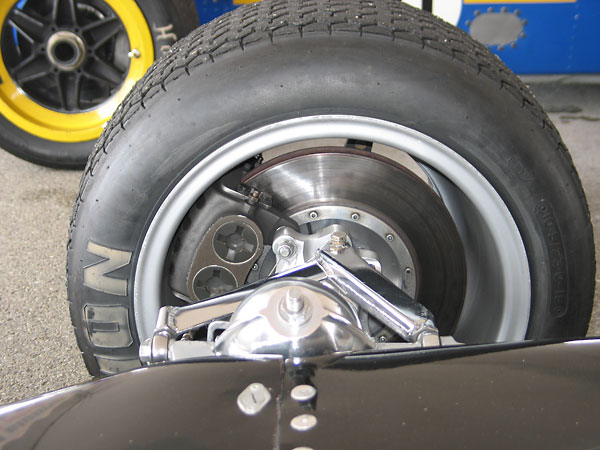
�
Armstrong CP2271 four-piston calipers and vented rotors.
�
�
Rear Suspension
��
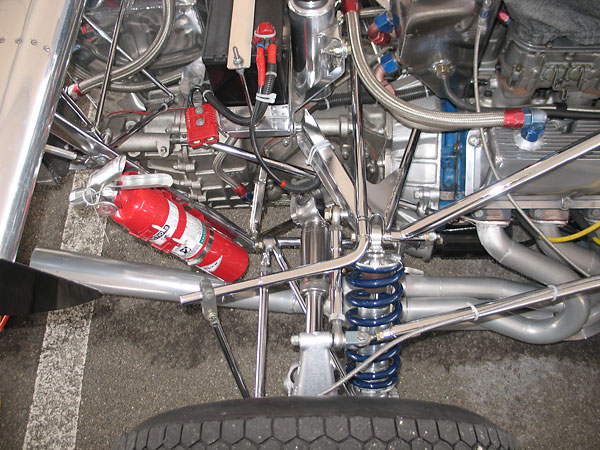
�
KONI 8212 double adjustable coilover shocks. They're similar to the fronts, except longer.
�
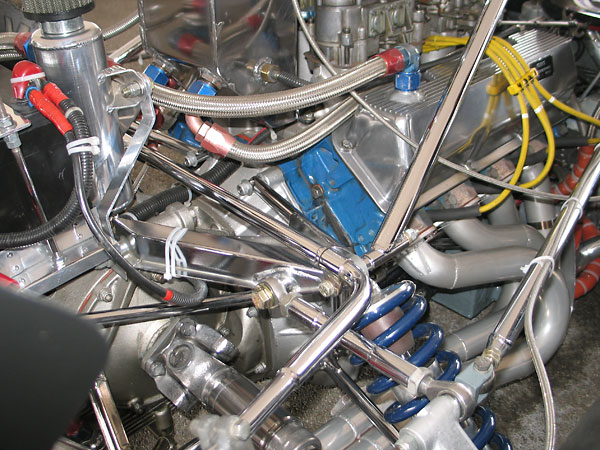
�
Canted-valve iron cylinder heads have their intake and exhaust valves on separate planes. They
�
aren't the lightest or the best flowing Ford heads by modern standards, but they're authentic.
�
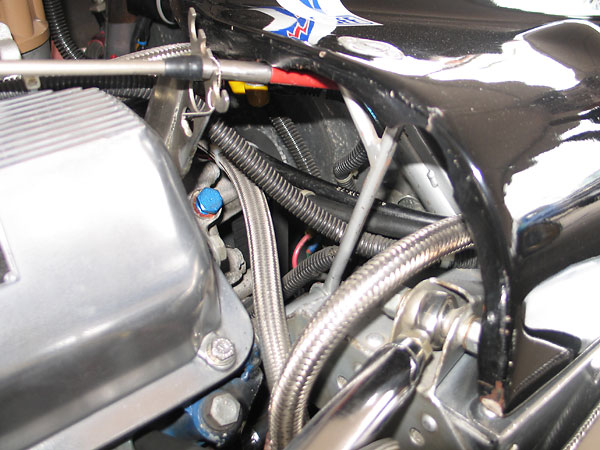
�
Connection of the trailing links to the aluminum monocoque tub.
�
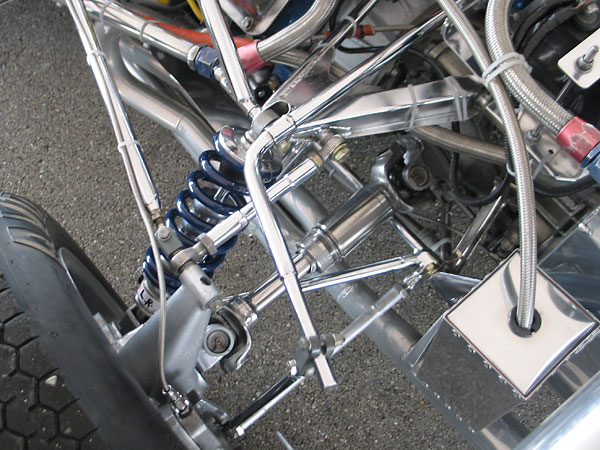
�
The rear anti-sway bar is designed for convenient fine adjustment.
�
Interior
��
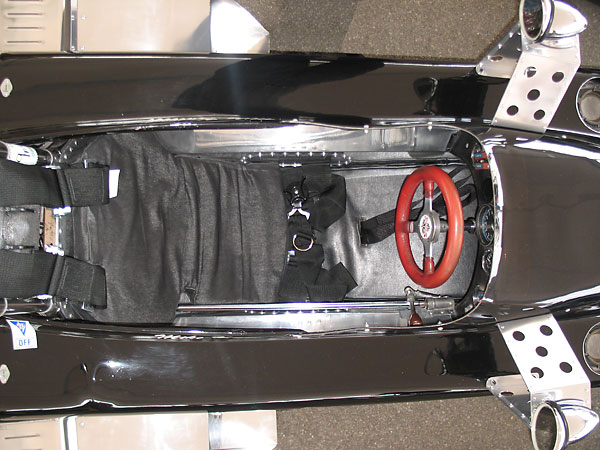
�
Overview of the Chinook Mk.12 cockpit.
�
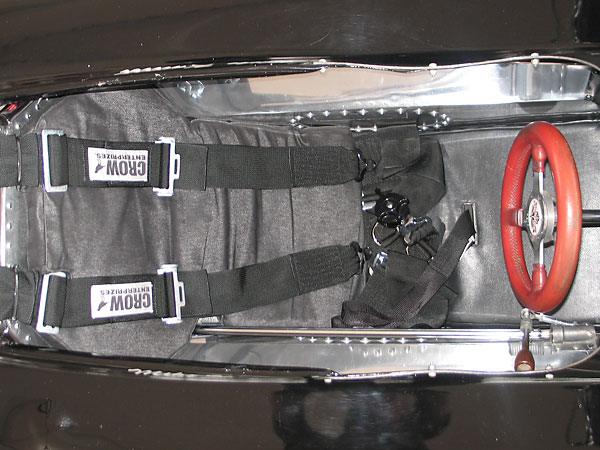
�
Crow Enterprises six-point cam-lock safety harness.
�
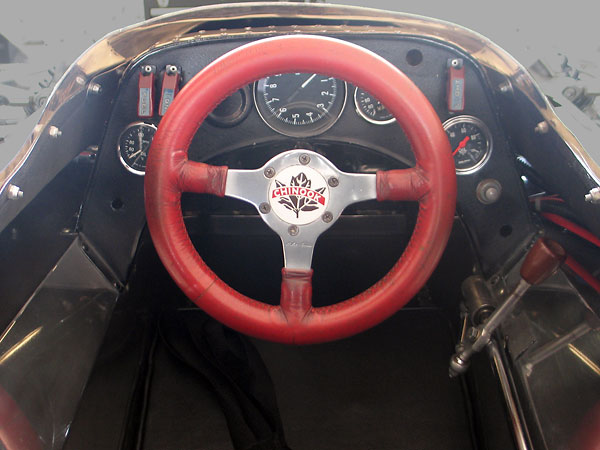
�
(left to right) Smith's oil temperature gauge (40-140C), Stewart Warner tachometer (0-9000rpm),
�
Smith's coolant temperature gauge (40-140C), and AutoMeter oil pressure gauge (0-100psi).
�
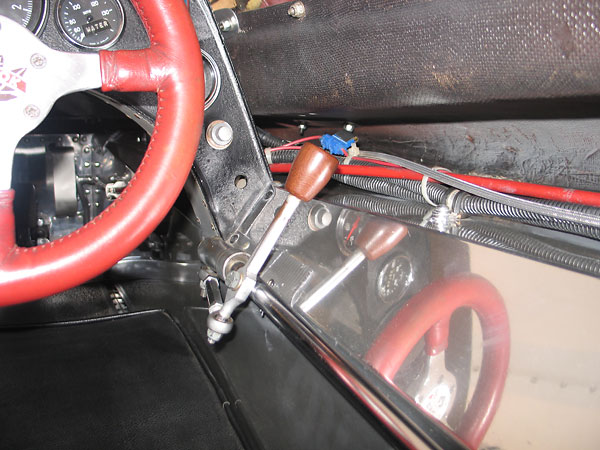
�
Shifter linkage.
�
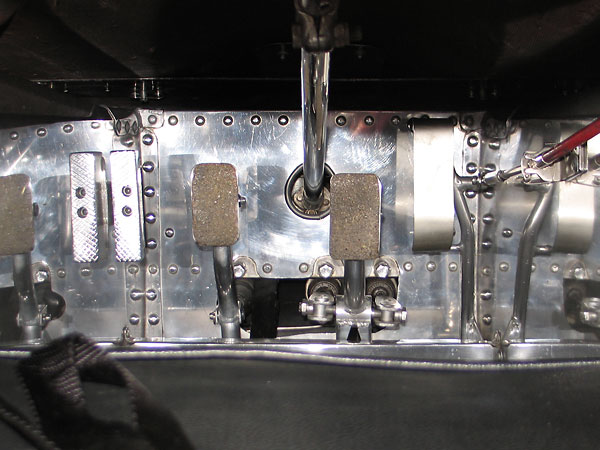
�
Polished footbox.
�
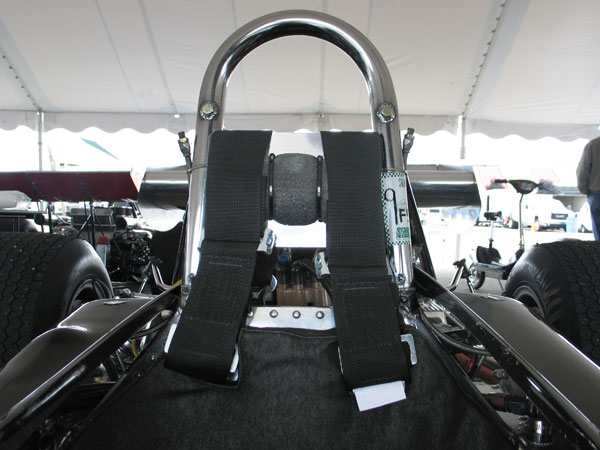
�
Rollhoop and headrest.
�
�
Exterior
��
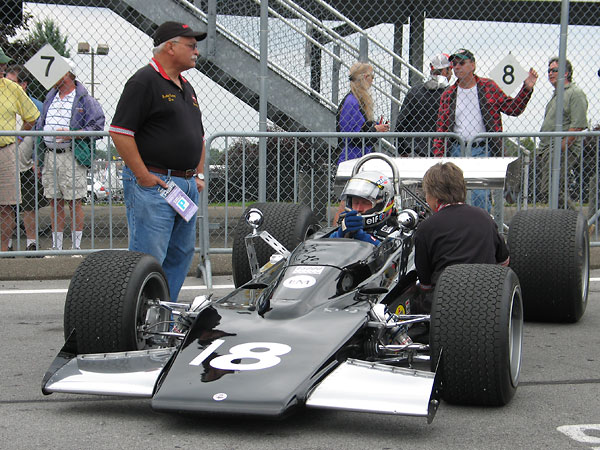
�
Mike's supportive wife helps him prepare for each race.
�
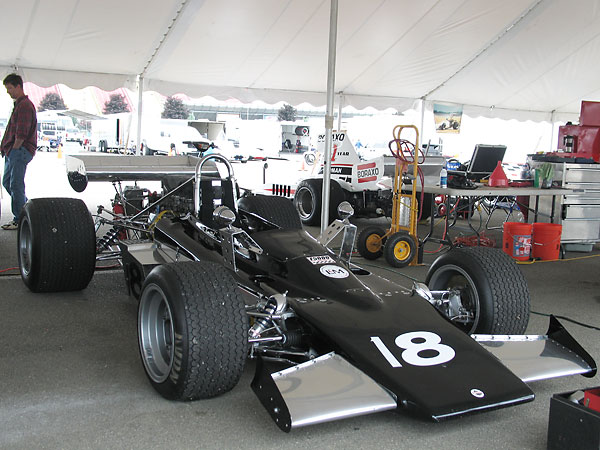
�
Back in the Formula 5000 paddock.
�
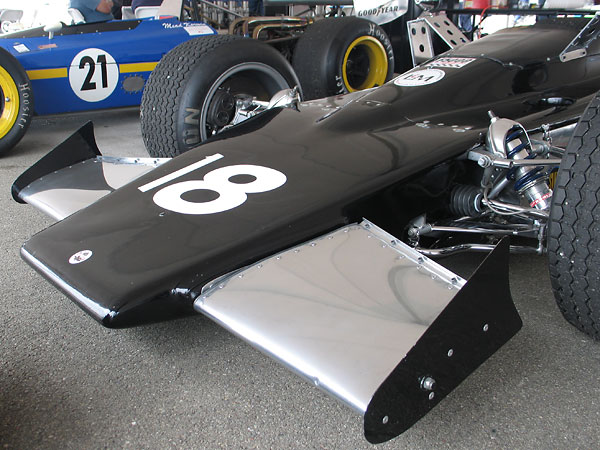
�
The front wings feature rake adjustment, generously sized side plates, and Gurney lips.
�
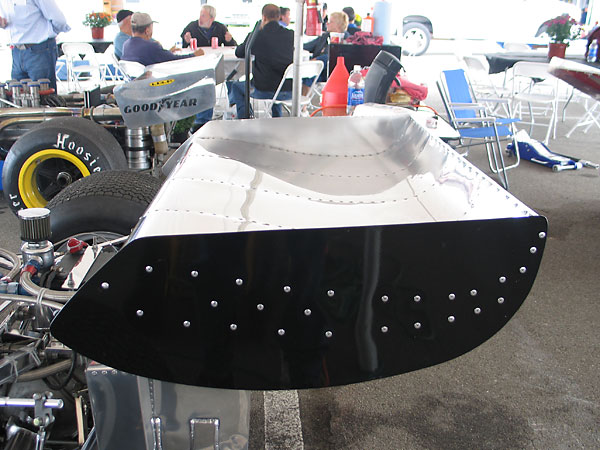
�
The rear wing.
�
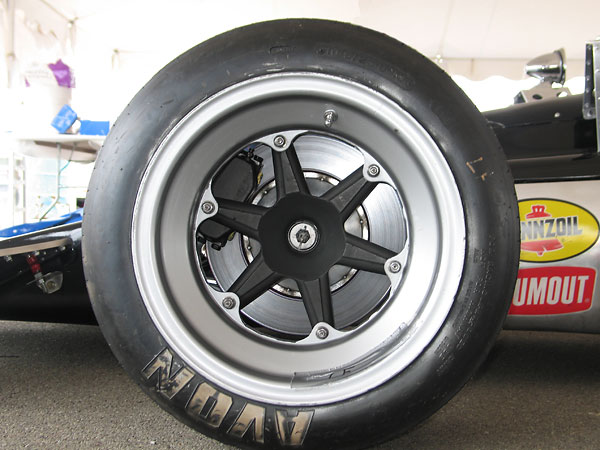
�
Cooper wheels.
�
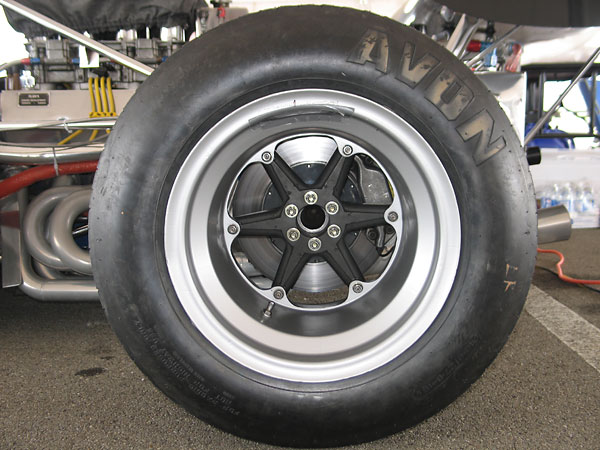
�
Avon tires (24x10.5x15 front and 27x15x15 rear).
�
| Notes: | |||||||
| (1) | �
Formula 5000 records show that Nat Adams of Hamilton Ontario drove a Chinook in �
the "L&M Continental Seattle Grand Prix" of June 7, 1970, but no car model �
designation appears in the records. The copper-colored car wore racing number 17. �
Adams qualified last of 33 cars entered, and completed only eight laps before �
retiring with engine problems. The race report indicates that a Chevy engine was �
being used in that race, but that may be inaccurate. �
� Three V8-powered Chinook cars participated briefly in the Canadian Formula A/5000 � series in 1969 and 1970. The race records appear to be incomplete, and the Mk.12 � model designation doesn't seem to have been recorded anywhere within them. � The three Chinooks could very well be entirely different designs. Three Chinooks,� two of them Chevy-powered and one Ford-powered, reportedly entered the � races at Harewood Acres on August 17 and again on September 27, 1969 but none of � the three cars finished either race. Two of these three apparently entered the season � finale at Mosport on October 14, but again neither car finished. Chinooks were � even less impressive in the 1970 season, and interest in the series seemed to be � dropping. The CASC didn't include Formula A in their calendar for 1971.� � There are unconfirmed reports that someone named Tony Nawrocki (possibly spelled � "Narocki") of Sardinia, NY raced the Chinook Mk12 in regional SCCA events during � 1973 and/or 1974. � � For more information about period Formula 5000 race results and much more we� enthusiastically recommend www.oldracingcars.com.� Allen Brown's online archive was our source for this notes section.� � | ||||||
�
All photos shown here are from September 2009 when we viewed the car at The US Vintage Grand �
Prix at Watkins Glen. All photos by Curtis Jacobson and Don Moyer for BritishRaceCar.com, copyright 2010. �
All rights reserved.
�
| If you liked this article, you'll probably also enjoy these: | �|||||
 | �
Ron Goldleaf '68 WRE Shadow | �
 | �
Paul Dudiak '69 McKee Mk12 | �
 | �
Eric Haga '70 Lola T190 | �
| You're invited to discuss anything you've seen here on The British Racecar Motorsports Forum! | �|||||
�
Notice: all the articles and almost all the photos on BritishRacecar.com are by Curtis Jacobson.
�
(Photos that aren't by Curtis are explicitly credited.) Reproduction without prior written permission is prohibited.
�
Contact us to purchase images or reproduction permission. Higher resolution images are optionally available.
�

 �
�